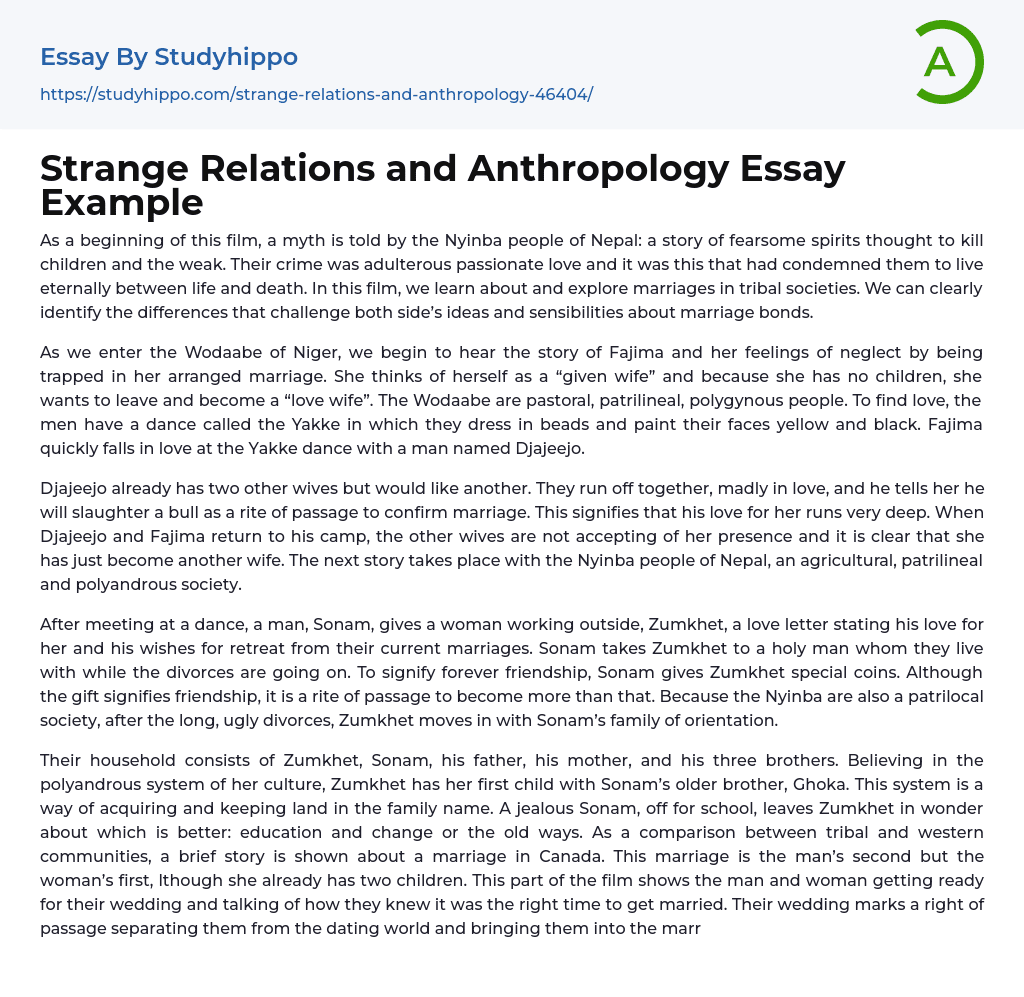As a beginning of this film, a myth is told by the Nyinba people of Nepal: a story of fearsome spirits thought to kill children and the weak. Their crime was adulterous passionate love and it was this that had condemned them to live eternally between life and death. In this film, we learn about and explore marriages in tribal societies. We can clearly identify the differences that challenge both side’s ideas and sensibilities about marriage bonds.
As we enter the Wodaabe of Niger, we begin to hear the story of Fajima and her feelings of neglect by being trapped in her arranged marriage. She thinks of herself as a “given wife” and because she has no children, she wants to leave and become a “love wife”. The Wodaabe are pastoral, patrilineal, polygynous pe
...ople. To find love, the men have a dance called the Yakke in which they dress in beads and paint their faces yellow and black. Fajima quickly falls in love at the Yakke dance with a man named Djajeejo.
Djajeejo already has two other wives but would like another. They run off together, madly in love, and he tells her he will slaughter a bull as a rite of passage to confirm marriage. This signifies that his love for her runs very deep. When Djajeejo and Fajima return to his camp, the other wives are not accepting of her presence and it is clear that she has just become another wife. The next story takes place with the Nyinba people of Nepal, an agricultural, patrilineal and polyandrous society.
After meeting at a dance, a man, Sonam, gives a woman working outside
Zumkhet, a love letter stating his love for her and his wishes for retreat from their current marriages. Sonam takes Zumkhet to a holy man whom they live with while the divorces are going on. To signify forever friendship, Sonam gives Zumkhet special coins. Although the gift signifies friendship, it is a rite of passage to become more than that. Because the Nyinba are also a patrilocal society, after the long, ugly divorces, Zumkhet moves in with Sonam’s family of orientation.
Their household consists of Zumkhet, Sonam, his father, his mother, and his three brothers. Believing in the polyandrous system of her culture, Zumkhet has her first child with Sonam’s older brother, Ghoka. This system is a way of acquiring and keeping land in the family name. A jealous Sonam, off for school, leaves Zumkhet in wonder about which is better: education and change or the old ways. As a comparison between tribal and western communities, a brief story is shown about a marriage in Canada. This marriage is the man’s second but the woman’s first, lthough she already has two children. This part of the film shows the man and woman getting ready for their wedding and talking of how they knew it was the right time to get married. Their wedding marks a right of passage separating them from the dating world and bringing them into the married world. Like the Nyinba tribe, a gift is given in the wedding ceremony to show this but instead of coins they exchange rings. David Maybury-Lewis gives us viewers some insight on romantic love, being in love and just plain old love.
He says that being
in love is a need for possession because we feel incomplete and this is usually why we marry. The problem we have is that feeling fades. He also says that romantic love threatens the family. Societies need people who will live for their children, not those who will die for love. This film showed the many different aspects of marriage and family in which we learned about in class. It gave examples of some types of marriages such as polygyny practiced in Niger, polyandry practiced in Nepal, and monogamy practiced in the west.
The residential patterns within the cultures also related to what we had learned in class such as the patrilocal living arrangements. I thought it was interesting to see all the different types of ways in which the rite of passage of marriage was achieved I personally did not enjoy watching this film. My only reason is because the way it was put together made it very confusing but in the end I was able to understand. The film was very affective in helping me understand the different sets of marriages, kinship, households and patterns of life.
- Population essays
- Cultural Assimilation essays
- Demography essays
- Ethnographic essays
- Population Growth essays
- Anthropology essays
- Audience essays
- Charity essays
- Cultural Competence essays
- Emile Durkheim essays
- Gender Roles essays
- Generation essays
- Globalization essays
- Interpersonal Relationship essays
- People essays
- Race essays
- Social Change essays
- Social Class essays
- Social Movement essays
- Social Science essays
- Social Status essays
- Social Stratification essays
- Society essays
- Sociological Imagination essays
- Sociological Perspective essays
- Sociological Theories essays
- Stereotypes essays
- Web Dubois essays
- Adoption essays
- Aunt essays
- Babies essays
- Bedroom essays
- Caring essays
- Children essays
- Daughter essays
- Divorce essays
- Dog essays
- Dysfunctional Family essays
- Family Tradition essays
- Family Values essays
- Father essays
- Foster Care essays
- Friends essays
- Grandparent essays
- Home essays
- Hometown essays
- Husband essays
- Jealousy essays
- Love essays
- Marriage essays




